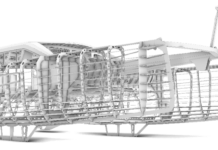
Assuming the COVID-19 restrictions allow us to launch this season, we have another worry on the horizon—hurricane season, which means chafe gear. Recently we got a hold of a new anti-chafe product, and a prototype from Chafe-pro, whose products have performed well in past tests.
Chafe-Mat
If you have a super yacht and like to keep everything just so, think of the chafe-mat as an industrial version of a mechanic’s fender guard. Drop one over each cleat to keep dock lines from cutting a groove in the gel coat. A pad of rubbery material on the inside keeps it from swaying, bolstered by weighted hems that keep the edges from flapping. The aren’t cheap—$85 standard or $125 with custom embroidery.
Bottom line: Fine idea, but a bit pricey compared to other conventional options (or a DIY solution). If we ever own a boat that justifies the Chafe-Mats we’ll buy a set, quit magazine writing, and head off to the islands full time.
Coated Chafe Guards
Although coated chafe guards are not common on cruising boats, a commercial version of the Chafe-pro’s coated chafe guards are used on tugs to protect 2- to 3-inch Dyneema lines where they pass through hawseholes.
To make the coated chafe guards, a rope-specific polyurethane coating is squeegeed into the webbing and the webbing is placed on a mandrel while it dries to prevent it from curing flat. Rope-specific polyurethane coatings have a proven ability to increase wear resistance by 10 times when applied to nylon and polyester rope.
Made from several layers of the same materials used on smaller guards, they are polyurethane impregnated with Velcro closures and straps.
Small diameter Chafe Guard
We also looked at a smaller-diameter prototype. Although considerably stiffer than regular Chafe-Pro webbing, these would work for mooring pendants and storm prep on larger boats. We’re still testing the 1- to 1 ½-inch size prototype.
You could, of course, make your own. Buy some Chafe-Pro Webbing, coat it with Flexdel Rope Dip or Yale Maxijacket and you will have the most chafe protection money can buy, at least for now. We’ve used both for years and swear by them.





































thanks for the money-saving ideas, especially…..and for experienced reporting!!
What about using fire hose? I have read about using old fire hose, but at a yard sale I found a coil of new fire hose. I grabbed it fast, although I doubt anyone else there had the same potential use as I have.
I have used the same fire hose chaff gear for over 20 years!!! In Central America, South America, at the dock in the Sacramento Delta for over 10 years with crazy boat wakes. It’s good stuff. Nice to see somebody working on some alternatives though. Maybe do some comparison testing. That’s what Practical Sailor is really good at too 😎
Vinyl tubing is absolutely the most bang for the buck and lasts for a decade or more. Vinyl tubing around 1/8” larger ID than the rope OD is best. Pull the rope through as opposed to attempting to push it through. Get out your sailing palm and needle and sew the inboard end of the vinyl tube to the rope. You’ll have no chafe whatsoever through the sharpest fair lead . Btw why can’t hardware makers actually round out the inside edges of hawse pipes ?
Vinyl tubing is not normally recommended. It doesn’t allow water in a storm to penetrate and cool the line. As nylon lines are stretched and retract they generate heat which will cause them to fail.